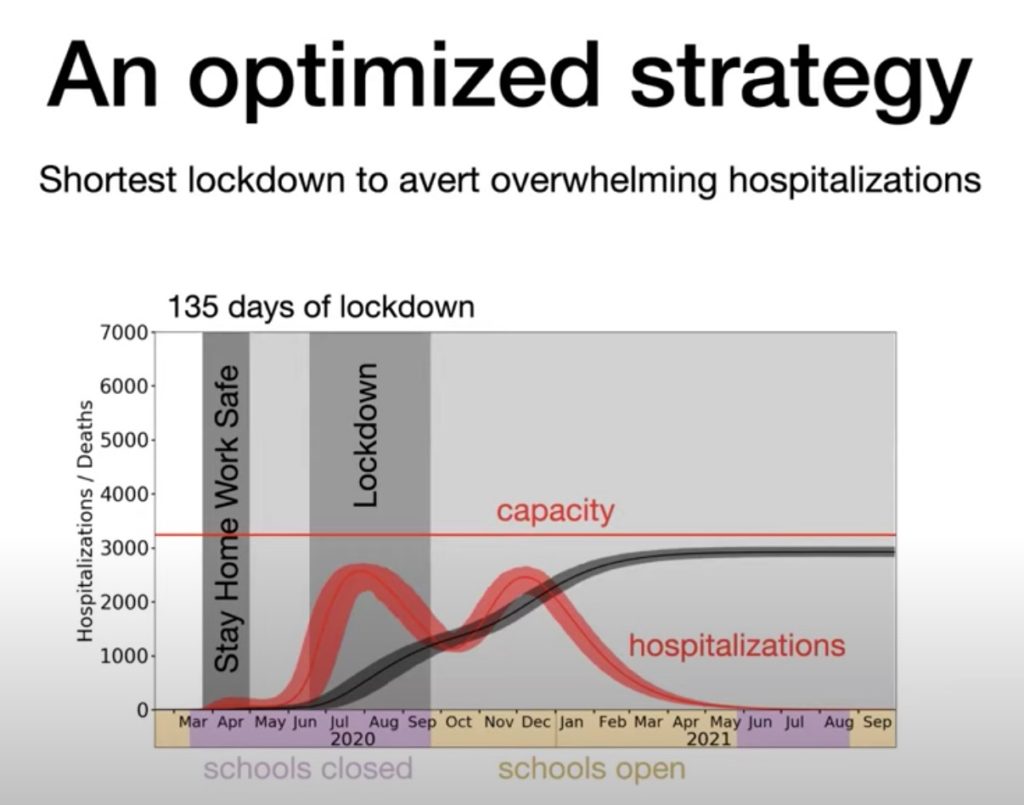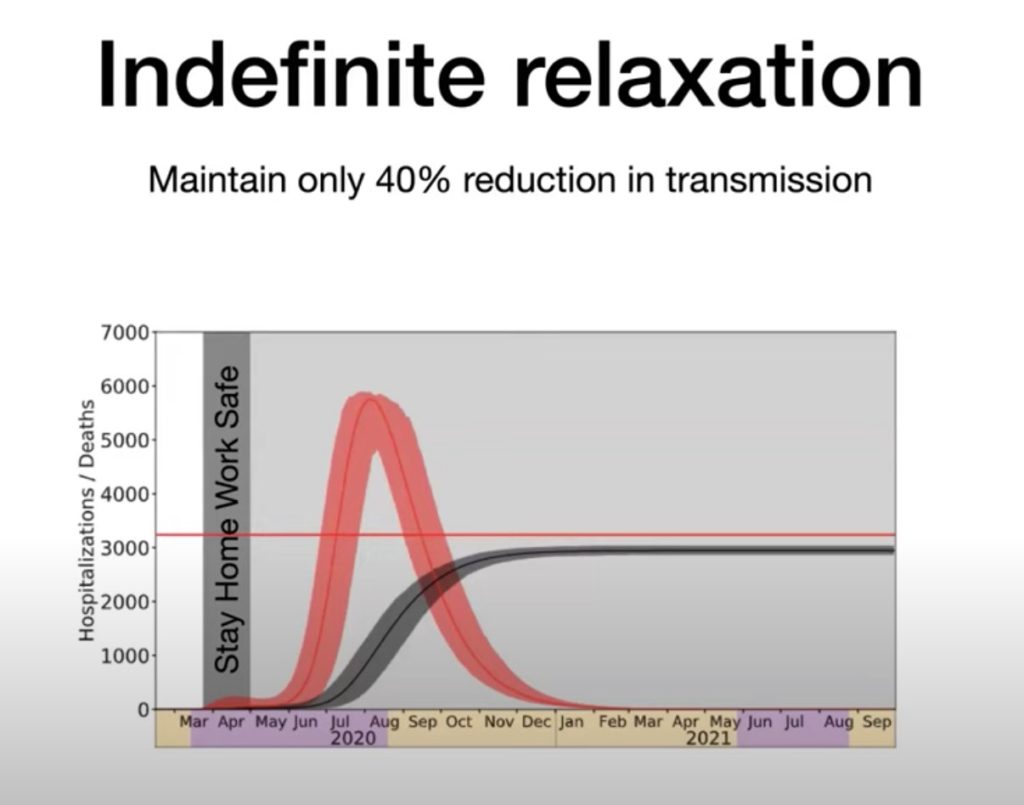A recently leaked recording caught Texas governor Greg Abbot admitting that the state’s May 1 reopening will result in a surge COVID-19 cases. On appearances, the clip confirms many people’s worst fears: that there is no plan at work in these reopenings. Governors are just throwing everything back open and letting ‘er rip, no matter how many people may die. “The Great YOLOing”, as I’ve been calling it, is about to commence, and only a miracle can save us.
But no! At closer glance, there is, in fact, a plan at work. Abbot and the rest of the state and local Texas government all knew about the coming ramp-up in cases. That ramp up in cases is part of the plan. Analysts have told them they can tamp it right back down with a second, much longer lockdown that could start in the summer and end in the fall.
Texas is probably not alone. Other governors likely expect second lockdowns later this summer. More states will no doubt follow suit. With guidance from the UT Austin model, they’ll attempt to close back up and keep the curve flat enough for their hospital systems to handle the load.
The coming wave of lockdowns isn’t a big, dark secret. You just have to know where to look.
Burying the second-lockdown-lede
The next lockdown wave is probably the biggest buried lede in the current acrimonious debates over models. But the evidence of a second wave is right there in at least two of the CDC’s core models. Indeed, UT Austin’s LBJ School of Government sets out the expectation that there will be a brand new mid-summer 100-day Texas lockdown in this recent video:
In the above video, which is very much worth watching in full, Dr. Lauren Ancel Meyers, a professor in the Departments of Integrative Biology and Statistics and Data Sciences at the University of Texas at Austin, walks us through UT Austin’s sophisticated machine-learning-based projections. What’s most critical about this model is that it takes up-to-date mobile GPS data into account. That data shows travel patterns, so the modelers can roughly gauge the level of distancing in real-time.
The UT Austin model described in this video is one of the handful of models the CDC looks at when making its own forecasts. It’s also the primary model guiding the response for both the State of Texas and the Austin metro area.
This version of this model that’s published on the web assumes that the current level of social distancing (whatever that happens to be on a given day, per the GPS data) extends indefinitely into the future. So when I first looked at it on April 30th after I watched the above video, it showed a Texas with a 97 percent probability of being past the peak.
At the time, the model got its “97% probability that the peak has already passed” number from then-current GPS data. The data showed that the state was still locked down. It furthermore assumed that we had reduced the virus’s transmission by 90 percent during our lockdown.
Models factor in reopening changes
But as of this writing, we’ve opened back up for a few days. The GPS data is now telling the model that we’re moving around more. This means our odds of being past the peak have dropped to just 60 percent, given the public’s new friskiness.
That “past the peak” probability will keep dropping as the reopening progresses. Then, at some point soon, the peak will be more likely in the future than the past. The above video lays this out in the following slide. Upon reopening, mask usage and other ongoing social distancing measures will cut the virus’s transmission will by just 40 percent.
If transmission falls by just 40 percent, the UT Austin model shows that hospitalizations and deaths could start to rise again. Then, at some point in late June, a second, 100-day lockdown could be required to flatten the curve back down and keep the hospitals from overloading.
If we don’t get that second, longer wave of lockdowns, then the hospital systems will be overwhelmed and the deaths could rise to unacceptable levels:
Austin model not alone in projections
Like the UT Austin model, the CDC-approved model at covid19-projections.com also assumes that in many states that open up, a second wave of lockdowns will keep the curve flat. This is buried in the “Assumptions” of the “About” page:
Second lockdown
In the case where the infections curve begin to rise exponentially after a reopening, it may become necessary for regions to impose a second lockdown. Starting from our May 1 projections, we began incorporating into our model the concept of a second lockdown, which we estimate will happen approximately 30 days after the reopening. A second lockdown is only necessary if the effective reproductive number (R) is greater than 1.
My guess is that these are not the only two modeling teams telling the CDC and state governments that the reopenings will drive the numbers up. More than one team likely knows a second lockdown is in the cards for many states.
Earlier in the pandemic, we reported on a study that showed we could be social distancing until 2022. Now, it seems at least one more wave of lockdowns is projected to be a part of that.
Will anyone comply with another lockdown wave?
States are free to order a second wave of lockdowns. But I have my doubts that we’ll see the level of compliance that we’ve seen with the first lockdowns.
Already, protests against the lockdowns are spreading, growing, and edging closer to violence. People are scared and righteously angry. Frankly, it’s hard to blame them on either score.
If you’re in a state like Michigan or Louisiana, where almost all the COVID cases are confined to a large metro area (Detroit and New Orleans, respectively), you’re probably looking around at the empty hospitals in your town and wondering why your community has to suffer when it’s not being hit by the virus.
So the anger over lockdowns seems fairly rational to me, though some of the protestors’ tactics are definitely not. And I can only see things getting uglier if a second big lockdown is called for. Areas that have escaped the worst will explode at being asked to hunker back down, and if it’s for a far longer time period (as in the Texas projection) then the economic costs will be unimaginable.
Whether it’s universal mask-wearing, or something along the lines of test, trace, and isolate, we need to come up with a way to avoid more lockdowns, and we need to do it within the next four weeks.





You are reporting the comment """ by on